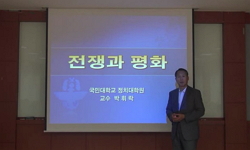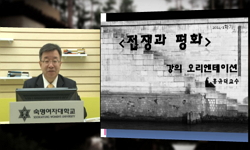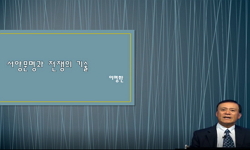The purpose of this study is to make clear the very core of Erasmus’ pacifism by analyzing his A Complaint of Peace(Querela pacis) and On the War against the Turks(De bello turcico). The sixteenth century Europe was threatened with the wars of Ottom...
http://chineseinput.net/에서 pinyin(병음)방식으로 중국어를 변환할 수 있습니다.
변환된 중국어를 복사하여 사용하시면 됩니다.
- 中文 을 입력하시려면 zhongwen을 입력하시고 space를누르시면됩니다.
- 北京 을 입력하시려면 beijing을 입력하시고 space를 누르시면 됩니다.
https://www.riss.kr/link?id=A102102221
- 저자
- 발행기관
- 학술지명
- 권호사항
-
발행연도
2016
-
작성언어
Korean
- 주제어
-
KDC
231.05
-
등재정보
KCI등재
-
자료형태
학술저널
-
수록면
101-134(34쪽)
-
KCI 피인용횟수
3
- DOI식별코드
- 제공처
- 소장기관
-
0
상세조회 -
0
다운로드
부가정보
다국어 초록 (Multilingual Abstract)
The purpose of this study is to make clear the very core of Erasmus’ pacifism by analyzing his A Complaint of Peace(Querela pacis) and On the War against the Turks(De bello turcico). The sixteenth century Europe was threatened with the wars of Ottoman Empire externally, and suffered from intensified conflicts between Roman Catholics and Protestants internally. In the midst of social upheaval, Erasmus as a Christian humanist asserted his stand against war and expressed his eager desire for peace.
Querela pacis shows his stance as a radical pacifist, while De bello turcico discloses his aspect as a realistic pacifist. In Querela pacis Erasmus assume a critical attitude towards every form of war. Erasmus made sharp criticisms on the concepts of ‘just war’ and ‘holy war,’ much less greedy wars. Therefore Erasmus could not help taking unjust peace rather than just war. However, in De bello turcico, Erasmus admitted the option of war as a last resort in the historic context of the Turks assault. Of course he continued to assume a prudent attitude towards war, but his tone was slightly changed. No matter what people evaluate Erasmus’ pacifism, his earnest desire for peace still give deep impressions and useful insights to us in the 21<SUP>st</SUP> century Korea. “The greatest element in peace is a heartfelt desire for it.”
다국어 초록 (Multilingual Abstract)
The purpose of this study is to make clear the very core of Erasmus’ pacifism by analyzing his A Complaint of Peace(Querela pacis) and On the War against the Turks(De bello turcico). The sixteenth century Europe was threatened with the wars of Ottom...
The purpose of this study is to make clear the very core of Erasmus’ pacifism by analyzing his A Complaint of Peace(Querela pacis) and On the War against the Turks(De bello turcico). The sixteenth century Europe was threatened with the wars of Ottoman Empire externally, and suffered from intensified conflicts between Roman Catholics and Protestants internally. In the midst of social upheaval, Erasmus as a Christian humanist asserted his stand against war and expressed his eager desire for peace.
Querela pacis shows his stance as a radical pacifist, while De bello turcico discloses his aspect as a realistic pacifist. In Querela pacis Erasmus assume a critical attitude towards every form of war. Erasmus made sharp criticisms on the concepts of ‘just war’ and ‘holy war,’ much less greedy wars. Therefore Erasmus could not help taking unjust peace rather than just war. However, in De bello turcico, Erasmus admitted the option of war as a last resort in the historic context of the Turks assault. Of course he continued to assume a prudent attitude towards war, but his tone was slightly changed. No matter what people evaluate Erasmus’ pacifism, his earnest desire for peace still give deep impressions and useful insights to us in the 21<SUP>st</SUP> century Korea. “The greatest element in peace is a heartfelt desire for it.”
목차 (Table of Contents)
- I. 서론
- II. 『평화의 탄식』에 나타난 에라스무스의 평화주의
- III. 『투르크족에 대항하는 전쟁에 관하여』에 나타난 에라스무스의 평화주의
- IV. 결론
- 참고문헌
- I. 서론
- II. 『평화의 탄식』에 나타난 에라스무스의 평화주의
- III. 『투르크족에 대항하는 전쟁에 관하여』에 나타난 에라스무스의 평화주의
- IV. 결론
- 참고문헌
- Abstract
참고문헌 (Reference)
1 베인튼, 롤란드, "에라스무스" 현대지성사 1998
2 Dust, Philip C., "Three Renaissance Pacifists:Essays in the Theories of Erasmus, More, and Vives" Peter Lang 33-48, 1987
3 Erasmus, "The Erasmus Reader, Edited by Erika Rummel" University of Toronto Press 15-20, 2014
4 Erasmus, "The Erasmus Reader, Edited by Erika Rummel" University of Toronto Press 288-314, 2014
5 Erasmus, "The Erasmus Reader" University of Toronto Press 21-49, 2014
6 Erasmus, "The Erasmus Reader" University of Toronto Press 315-333, 2014
7 Erasmus, "The Complaint of Peace" The Open Court Publishing Co 1917
8 Luther, Martin, "The Christian in Society III. Vol. 46. Luther’s Works" Fortress Press 155-205, 1967
9 Trapman, Hans, "Images of Erasmus" Museum Boijmans Van Beuningen 13-33, 2008
10 Augustijn, Cornelis, "Erasmus: His Life, Works, and Influence" University of Toronto Press 1995
1 베인튼, 롤란드, "에라스무스" 현대지성사 1998
2 Dust, Philip C., "Three Renaissance Pacifists:Essays in the Theories of Erasmus, More, and Vives" Peter Lang 33-48, 1987
3 Erasmus, "The Erasmus Reader, Edited by Erika Rummel" University of Toronto Press 15-20, 2014
4 Erasmus, "The Erasmus Reader, Edited by Erika Rummel" University of Toronto Press 288-314, 2014
5 Erasmus, "The Erasmus Reader" University of Toronto Press 21-49, 2014
6 Erasmus, "The Erasmus Reader" University of Toronto Press 315-333, 2014
7 Erasmus, "The Complaint of Peace" The Open Court Publishing Co 1917
8 Luther, Martin, "The Christian in Society III. Vol. 46. Luther’s Works" Fortress Press 155-205, 1967
9 Trapman, Hans, "Images of Erasmus" Museum Boijmans Van Beuningen 13-33, 2008
10 Augustijn, Cornelis, "Erasmus: His Life, Works, and Influence" University of Toronto Press 1995
11 Pabel, Hilmar M., "Erasmus' Vision of the Church" Sixteenth Century Journal Publishers, Inc. 57-93, 1995
12 Luther, Martin, "Career of the Reformer I. Vol. 31. Luther’s Works" Fortress Press 1967
동일학술지(권/호) 다른 논문
-
- 연세대학교 신과대학(연합신학대학원)
- 권진호(Jin-Ho Kwon)
- 2016
- KCI등재
-
- 연세대학교 신과대학(연합신학대학원)
- 김정희(Jung-Hee Kim)
- 2016
- KCI등재
-
- 연세대학교 신과대학(연합신학대학원)
- 김창주(Changjoo Kim)
- 2016
- KCI등재
-
세월호 참사 보도에서 드러난 언론의 정치적 기능과 세월호 이후 크리스천 전문가들의 과제
- 연세대학교 신과대학(연합신학대학원)
- 송용섭(Yong Sup Song)
- 2016
- KCI등재
분석정보
인용정보 인용지수 설명보기
학술지 이력
| 연월일 | 이력구분 | 이력상세 | 등재구분 |
|---|---|---|---|
| 2022 | 평가예정 | 재인증평가 신청대상 (재인증) | |
| 2019-01-01 | 평가 | 등재학술지 유지 (계속평가) |  |
| 2016-01-01 | 평가 | 등재학술지 유지 (계속평가) |  |
| 2012-01-01 | 평가 | 등재학술지 선정 (등재후보2차) |  |
| 2011-01-01 | 평가 | 등재후보 1차 PASS (등재후보1차) |  |
| 2009-01-01 | 평가 | 등재후보학술지 선정 (신규평가) |  |
학술지 인용정보
| 기준연도 | WOS-KCI 통합IF(2년) | KCIF(2년) | KCIF(3년) |
|---|---|---|---|
| 2016 | 0.34 | 0.34 | 0.38 |
| KCIF(4년) | KCIF(5년) | 중심성지수(3년) | 즉시성지수 |
| 0.36 | 0.33 | 0.816 | 0.11 |





 DBpia
DBpia







